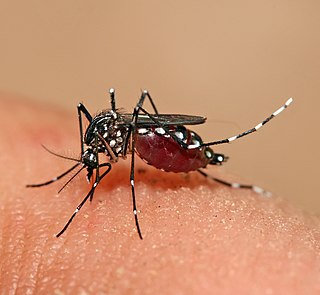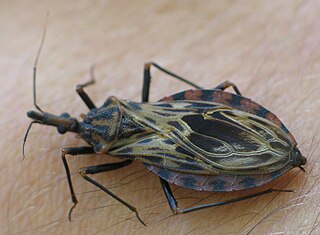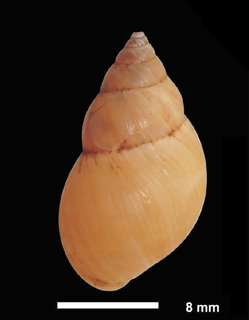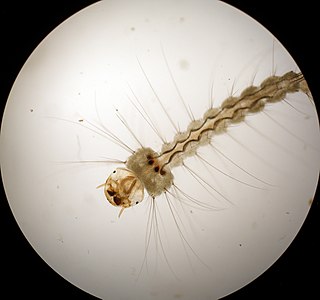Related Research Articles

Aedes is a genus of mosquitoes originally found in tropical and subtropical zones, but now found on all continents except Antarctica. Some species have been spread by human activity: Aedes albopictus, a particularly invasive species, was recently spread to the New World, including the United States, by the used-tire trade.

Adolfo Lutz was a Brazilian physician, father of tropical medicine and medical zoology in Brazil, and a pioneer epidemiologist and researcher in infectious diseases.

Triatoma nigromaculata is a sylvatic species of insect usually found in hollow trees, in vertebrate nests on trees and occasionally in human dwellings. It usually lives in relatively humid forests at high altitudes on mountain regions and foot hills. As all members of the subfamily Triatominae, T. nigromaculata is a blood-sucking bug and a potential vector of Chagas disease. This species is distributed mainly in Venezuela, but some specimens have also been found in Perú and Colombia (Cauca).

Chrysomya putoria, also known as the tropical African latrine blowfly, is a fly species belonging to the blowfly family, Calliphoridae.C. putoria is native to Africa and has recently spread to the Americas. These flies pose significant health risks, especially due to their close association with human settlements. Adult flies can carry pathogens, while larvae may cause myiasis by growing and feeding on the flesh of domestic animals and humans. Other myiasis-causing flies in the same genus are C. bezziana and C. megacephala. C. putoria and other flies that feed on decomposing tissue are used as important tools in forensic entomology to establish the post-mortem interval, or the time elapsed since death.
Dendropsophus meridianus is a species of frog in the family Hylidae. It is endemic to southeastern Brazil.
Aquascypha is a fungal genus in the family Meruliaceae. It is a monotypic genus, containing the single species Aquascypha hydrophora, found in Central and South America. This species forms cup-like structures with dimensions of 2.7 to 14.9 cm and heights of 6.1 to 18 cm. Study of this fungus in the Amazon rainforest showed that on average, these cups hold 35 millitres of water, in addition to organic matter such as leaves, flowers and fruits that fall from trees; this provides an ideal environment for various insect species to breed.
Hexachaeta bondari is a species of tephritid or fruit flies in the genus Hexachaeta of the family Tephritidae.

Bulimulus tenuissimus is a species of tropical air-breathing land snail, a pulmonate gastropod mollusk in the subfamily Bulimulinae.
Pintomyia falcaorum is an extinct species of sandfly in the moth fly subfamily Phlebotominae. P. falcaorum is solely known from early Miocene Burdigalian stage Dominican amber deposits on the island of Hispaniola.
Sabethes mosquitoes are primarily an arboreal genus, breeding in plant cavities. The type species is Sabethes locuples, first described by Jean-Baptiste Robineau-Desvoidy in 1827.
Lutzia shinonagai was first described in 1979. The genus name was originally spelled Lützia; the species name honors medical entomologist Dr. Satoshi Shinonaga who has published extensively on the taxonomy of the muscid, sarcophagid and calliphorid flies of Japan and the Oriental Region. Lutzia shinonagai is the only species in the subgenus Insulalutzia.
Bironella is one of the three mosquito genera in the subfamily Anophelinae. The other two genera are Anopheles Meigen and Chagasia Cruz (Neotropics).
Chagasia is one of the three mosquito genera in the subfamily Anophelinae. The other two genera are Anopheles Meigen and Bironella Theobald. The subfamily consists of five species in the Neotropical region. These include C. ablusa Harbach, C. bathana Dyar, C. bonneae Root, C. fajardi Lutz and C. rozeboomi Causey, Deane & Deane.

Leptoconops nosopheris is an extinct species of biting midges belonging to the family Ceratopogonidae. This species was described from fossilized remains preserved in Burmese amber from the Early Cretaceous. The amber containing the fossil was mined in the Hukawng Valley, in Kachin State, Myanmar

Wyeomyia is a genus of mosquitoes first described in 1901 by Frederick Vincent Theobald. The genus's 140 species can be difficult to characterize because of their diversity and the need for additional taxonomic work to further delineate them. Adults resemble genus Limatus and Sabethes mosquitoes more closely than other genera in the New World tribe Sabethini, but differ by their scutal scales ranging in color from a relatively dull bronzy with a slight metallic sheen in most species, to a metallic gold. There are other distinguishing characters as well.
Opeatocerata is a genus of flies in the family Empididae.
Opeatocerata cooperi is a species of dance flies, in the fly family Empididae.
Opeatocerata lopesi is a species of dance flies, in the fly family Empididae.
Opeatocerata stubbsi is a species of dance flies, in the fly family Empididae.
Aedes scapularis is a species of mosquito primarily found in neo-tropical regions of the Americas.
References
- 1 2 Thomas V. Gaffigan, Richard C. Wilkerson, James E. Pecor, Judith A. Stoffer and Thomas Anderson. 2016. "Culicidae » Culicinae » Sabethini » Genus Sabethes" in Systematic Catalog of Culicidae, Walter Reed Biosystematics Unit, http://www.mosquitocatalog.org/taxon_descr.aspx?ID=48, accessed 2 Mar 2016.
- 1 2 3 Belkin, John N. (1968). "Mosquito Studies (Diptera, Culicidae) IX. The type specimens of New World mosquitoes in European museums". Contributions of the American Entomological Institute. 3 (4): 1–69.
- ↑ Frederick V. Theobald. 1903. A monograph of the Culicidae or Mosquitoes. London: Brit. Mus. (Natur. Hist.) Vol. III, p. 323; http://babel.hathitrust.org/cgi/pt?id=uiug.30112010058789;view=1up;seq=347.
- ↑ Lima, A. da Costa (February 1931). "Sobre as especies dos generos Sabethes e Sabethoides: (Diptera: Culicidae)" [On the species of the genera Sabethes and Sabethoides: (Diptera: Culicidae)]. Memórias do Instituto Oswaldo Cruz (in Portuguese). 25 (1): 51–64. doi: 10.1590/S0074-02761931000100003 .
- ↑ Marchon-Silva, Verônica; Lourenço-de-Oliveira, Ricardo; Almeida, Magaly Dolsan de; Silva-Vasconcelos, Adenildo da; Costa, Jane (August 1996). "The type specimens of mosquitoes (Diptera, Culicidae) deposited in the entomological collection of the Instituto Oswaldo Cruz, Rio de Janeiro, Brazil". Memórias do Instituto Oswaldo Cruz. 91 (4): 471–478. doi: 10.1590/S0074-02761996000400014 .
| | This mosquito article is a stub. You can help Wikipedia by expanding it. |